On my 30th birthday, I experienced the most amazing meal I've ever had to date.
I use the word "experienced" rather than "ate" because a meal at Tapas Molecular Bar is not just about eating meticulously prepared creative dishes. It's a show. A sensory experience that surprises and delights all of your senses, not just your taste buds. It's Cirque du Soleil meets culinary perfection. Every dish invokes oohs and aahs and mmms, and occasionally a gasp of surprise. One dish caused all the guests to erupt in laughter. During two entertaining hours, the two chefs prepare and serve a parade of twenty courses, explaining each dish (because often it's not what it looks like, or contains elements you wouldn't expect) in English and Japanese.
Located on the 38th floor of the Mandarin Oriental in Tokyo, Tapas Molecular Bar has just 7 seats with two seatings per night (for the mathematically challenged, that means only 14 people get to experience this gastronomic magic show each night), one at 6 pm and one at 8:30 pm. And dinner starts promptly at the appointed time so it is imperative that you aren't late because part of the experience is watching the chefs prepare the dishes and having them explain each dish to you. It's best to arrive a bit early and relax with an aperitif in the bar/lounge area, which boasts gorgeous views of the Nihonbashi area. At only 14,000 yen (~$150) per person for 20 courses, I absolutely think that dinner at Tapas Molecular Bar is the BEST bang for your buck for a high-end meal you will ever find, anywhere.
Dinner at Tapas Molecular Bar on my 30th birthday with my favorite guy? An unforgettable perfect meal.

Autumn menu
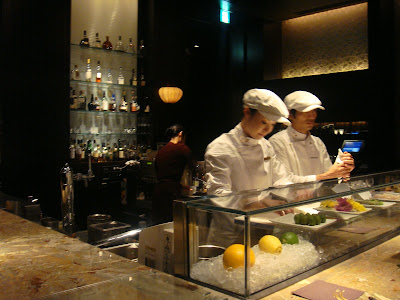
Our chefs and hosts
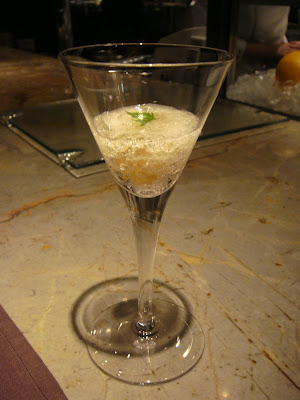
Aperitif - muscat gelee and muscat grape

Matsutake gohan (mushroom and rice) with jamon iberico - on the left is a cracker that tastes just like matsutake mushroom and a bowl of rice, on the right is a brittle made with jamon iberico

Apple crisp cigar wrapped around Manchego cheese sorbet

Kobujime sea bream with ball of sour plum (umeboshi) tea
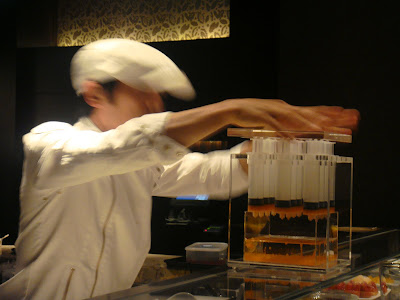
The chef using chemistry to create "carrot caviar"

Carrot caviar, served with passionfruit jus

Baked scallop with curried pumpkin sorbet, lime foam, asparagus, pepper cream sauce and pistachio dust

Slow-cooked sanma (Pacific saury) with tonka leaf, gingko nut and parsnip puree (one of my favorite "main" dishes)

"Smoke" - venison tartar with mustard (in egg yolk-like sac) and Asian pear. When the glass was lifted, smoke started lifting from the plate and you could smell the delicious scent of smoked meat
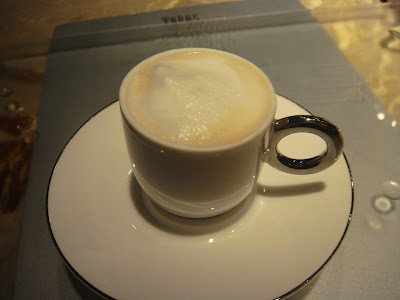
Cepe mushroom soup with stewed chestnut

Wagyu beef seasoned with charcoal oil, slow-cooked in a vacuumed bag at low temperature for 10 hours

Salmon - baked salmon served on top of salmon tartar with pumpkin seeds and lentil salad. The only dish out of the 20 that fell a little flat...there's only so much you can do with salmon to make it creative/special. The dish was good, but it just tasted like salmon, with no special effects or creative subtle flavors

"Xialongbao" - a roast baby lamp chop with juices in the middle that squirt out when you bite or cut into it

Miso soup - a egg yolk like sac which actually has the texture of a slightly poached egg yolk but tastes exactly like miso soup, served with scallion oil, powdered nori and soybean milk caviar

"Peaches and Cream" - a lightly cooked berry peach with yogurt sauce

Yaki imo - a baked sweet potato, hand shaped into a meringue and dipped into liquid nitrogen immediately before it's served to you.
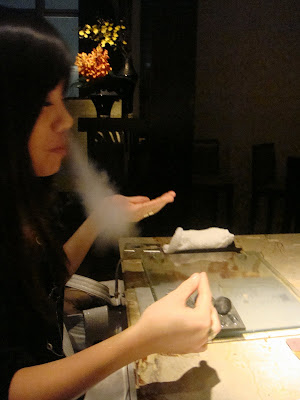
This is what happens after you put the liquid nitrogen-dipped sweet potato meringue into your mouth. The chefs served the men first and the women got a good laugh out of watching steam stream out of their dates' mouths and noses. The meringue itself almost disappears once you put into your mouth - one second it's there, the next second, it's just gone.

I thought I couldn't possibly eat anymore, but when they served this dessert tray, I magically found more room. The desserts included a donut hole filled with foie gras (sounds strange but was an absolutely delicious balance of sweet and savory), Kinako, Cappuccino, Raspberry Soda, Yuzu jelly and chocolate pumice (a slab of chocolate that looks and feels like a pumice - the stone you slough your feet with - and melts in your mouth)

Kinako - a spongy confection covered with soybean cake-like crumbs
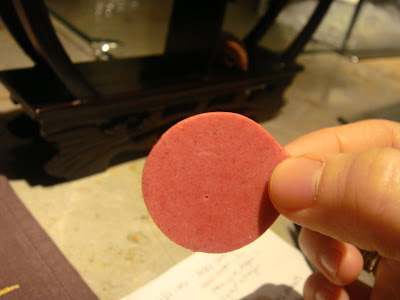
"Raspberry soda" - a creamy sweet candy disc that, when you place on your tongue, starts to fizz with carbonation and tastes like...raspberry soda

"Cappuccino" - cotton candy that tastes just like a cappuccino

The seed of the "miracle fruit" - a tiny red fruit that makes sour fruit taste sweet. You eat the miracle fruit and suck on the seed for a minute (the chefs actually use an hourglass timer), cleanse your palate with water and afterward even the most sour lemon tastes like the sweetest fruit you've ever had
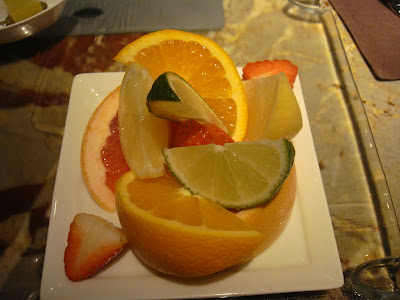
After eating the "miracle fruit," lemons, limes, oranges and grapefruit tasted like the sweetest fruit I'd ever had in my life. I seriously wished for a bucket of lemons.
Food rating: ***** (ok so a couple dishes fell short - but most were amazing, and there were 20 courses!)
Bang for buck rating: 5 (an amazing dining experience, totally worth it!)
The essentials:
http://www.mandarinoriental.com/tokyo/dining/molecular/
Location: 38th floor of Mandarin Oriental hotel in Nihonbashi, Tokyo
Average price of meal for two: 30,000 yen (~$330)